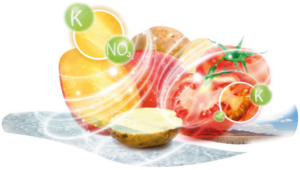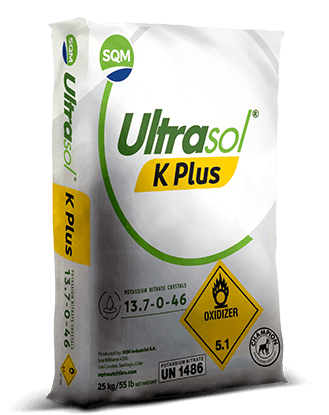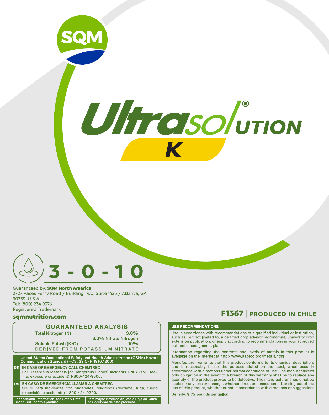The FAO has anticipated that between now and 2050 agricultural production worldwide will have to double, if we are to meet the demand for food for a growing population that will reach 9.8 million people in 30 years.
Selecting the right fertilizers will continue to be an important part of the equation to improving yield, quality and shelf life of crops. But even more vital will be their application. Let's examine foliar spray.
Both laboratory and field tests (see charts) have pointed at foliar application of KNO3 as a powerful tool to boost both the quality and quantity of harvests. Scientific research has demonstrated that about 29 crops benefited from foliar sprays with KNO3. This includes field crops like beans, cotton and grain crops.
Besides, crops treated with foliar spray tend to have a higher nutritional value. Improved Total Soluble Solids (TSS) have contributed to increased sugar, vitamins, minerals and proteins in the harvested crops. It is not enough just to grow more crops, but those crops must be better for us as well.
Potassium (K) regulates plant functions and increases nitrogen efficiency. By increasing the saline concentration of the cells, the plants are better able to resist frosts. Applied correctly, potassium promotes stronger cell structure. This can result in prolonged shelf life in produce. Reducing enough waste to feed millions more. Potassium also improved drought, disease, and pest resistance. Scientists at the Delta Ag Center in Missouri and SQM scientists proved foliar KNO3 application reduced lodging in rice preventing increased harvest costs.
Originally it was thought that using KNO3 was only appropriate when a nutritional deficiency was present. However, with ongoing scientific research, it has consistently been shown that periodic applications can have a positive effect on both quantity and quality of fruits, nuts, vegetables, and grain crops. These studies include soil and climate conditions as well as yield data collected after applying foliar sprays of a KNO3 solution not only to nutritionally deficient crops, but even to crops that have adequate levels of potassium, such as wheat, almonds, tomatoes, citrus, cucurbits, among others.
Potassium nitrate sprays improved plant growth yield and fruit storability of cucumber.
The objective of this study was to evaluate the effects of sprays with calcium nitrate, potassium nitrate and Anfaton growth stimulator on plant growth, yield and fruit storability of soil grown cucumber cv. Al-Hytham in Iraq.

Table 1. Effect of sprays with potassium nitrate on plant characteristics of cucumber cv. Al-Hytham.
Three concentrations of Anfaton; 0. 600 and 1000 mg/L and five concentrations of spray solutions; 0 mM (control), 10 and 15 mM of calcium nitrate and 10 and 15 mM of potassium nitrate in addition to the combination of Anfaton and the two nutrients were used. The experiment was set up in a silt clay soil in a Complete Randomized Block Design (CRBD) with three replications. Spraying was conducted three times; first spray was applied 20 days after transplanting and repeated every 15 days for the second and third spray.
With respect to only potassium nitrate sprays, the foliar sprays with 15 mM KNO3 (1.5 g KNO3 /L) resulted in statistically significantly higher values for plant height, leaf area, chlorophyll content, average fruit weight, total number of fruits and the total yield compared to the control (Table 1 & 2). KNO3 sprays were also beneficial in controlling fruit weight loss and maintaining total soluble solids at higher level during storage.

Table 2. Effect of sprays with potassium nitrate on yield characteristics of cucumber cv.Al-Hytham.
On behalf of the Potassium Nitrate Association (PNA), Landlab research station in Quinto Vicentino (Italy), conducted a trial to test the effect on winter wheat yield of two foliar applications with potassium nitrate (KNO3) in spring, on top of KCl base dressing at four levels of K2O/ha. Potassium nitrate was sprayed at the growth stages of active tillering and panicle initiation at 10kg KNO3/400 L spray/ha. (9.6 lbs. KNO3/43 gal.spray/ac). The results show that the foliar application of KNO3 is promoting a higher yield compared to the untreated entries mainly due to more ears/m². The yield results are clear and statistically strongly supported at a very high level of confidence. The study confirms the benefit of potassium nitrate for wheat yield, applied twice as foliar spray, in the key moment of the crop cycle, even if KCl is provided in the base-dressing at sowing.
Wheat grain yield (MT/ha)
Recommended K2O level, applied as KCI in base dressing Figure 1. Effect of different base dressing applications and two foliar potassium nitrate sprays (10kg/400L spray/ha) or (9.6 lbs./ 43 gal. spray/ac.) at the growth stages of active tillering and panicle initiation on wheat grain yield.
Figure 1. Effect of different base dressing applications and two foliar potassium nitrate sprays (10kg/400L spray/ha) or (9.6 lbs./ 43 gal. spray/ac.) at the growth stages of active tillering and panicle initiation on wheat grain yield.
Above, control produced 107 bushels/acre at 0% recommended K2O level. Foliar spray of KNO3 increased the yield by 10.7 bushels/ac. At 75% KCL base the KNO3 foliar application increased yield by 17 bushels/acre. At 100% recommended base K2O from KCL K source control produced 111.5 bushels. The KNO3 foliar increased the total yield to 130.5 bushels/acre, a 17% (19 bushel) increase over the KCL base alone.
BY JW LEMONS
National Sales Agronomist SQM North America - Published in CropLife magazine, june 2019




